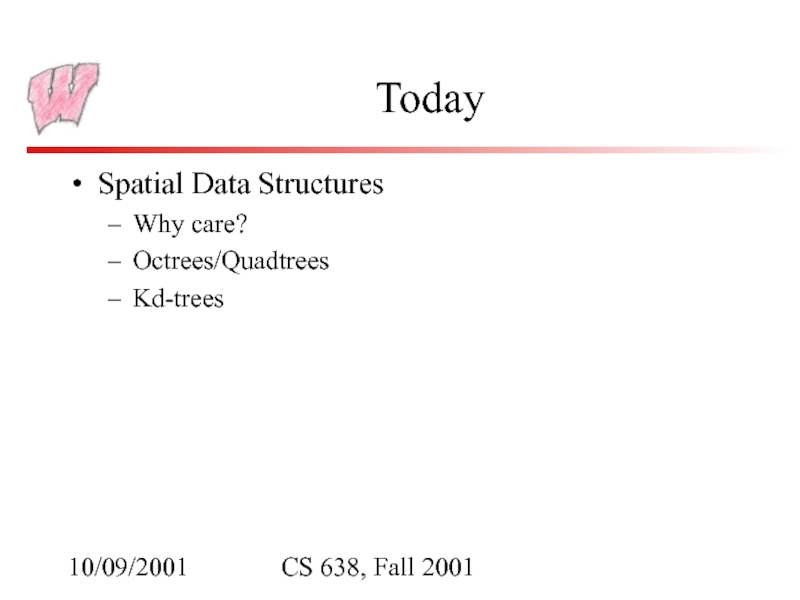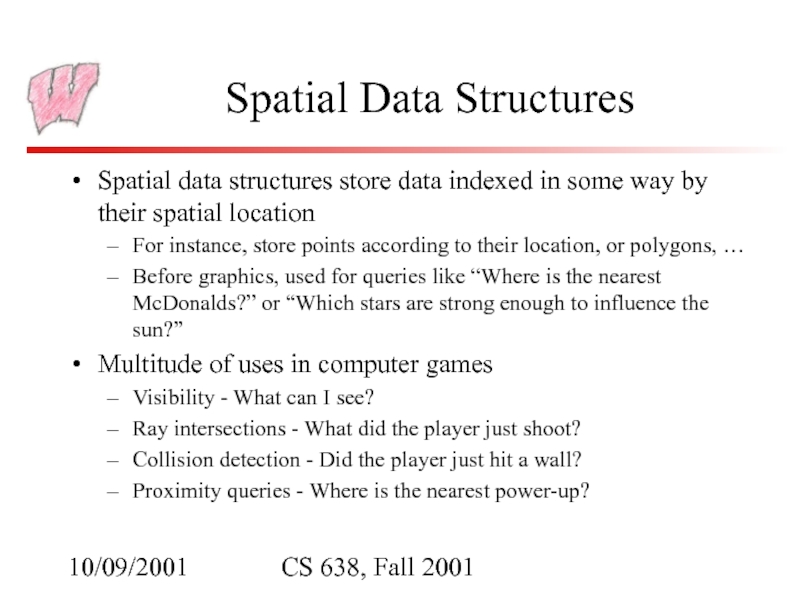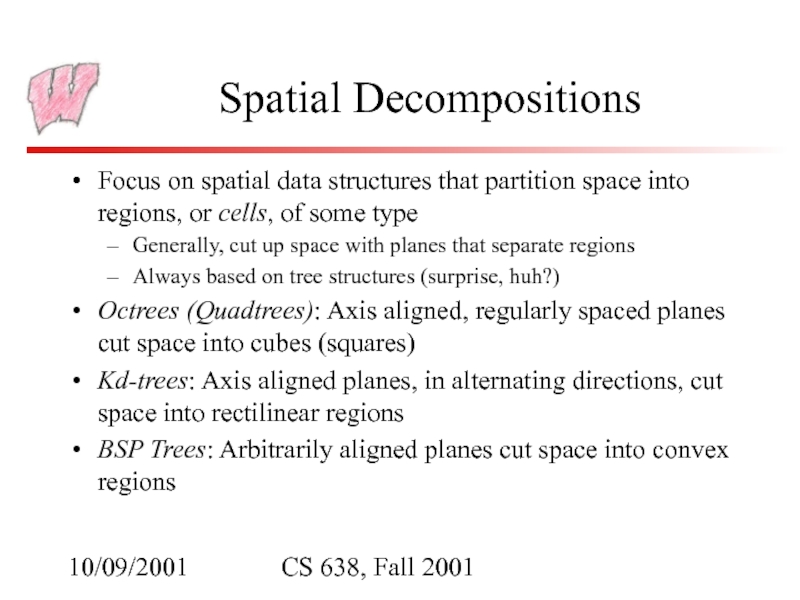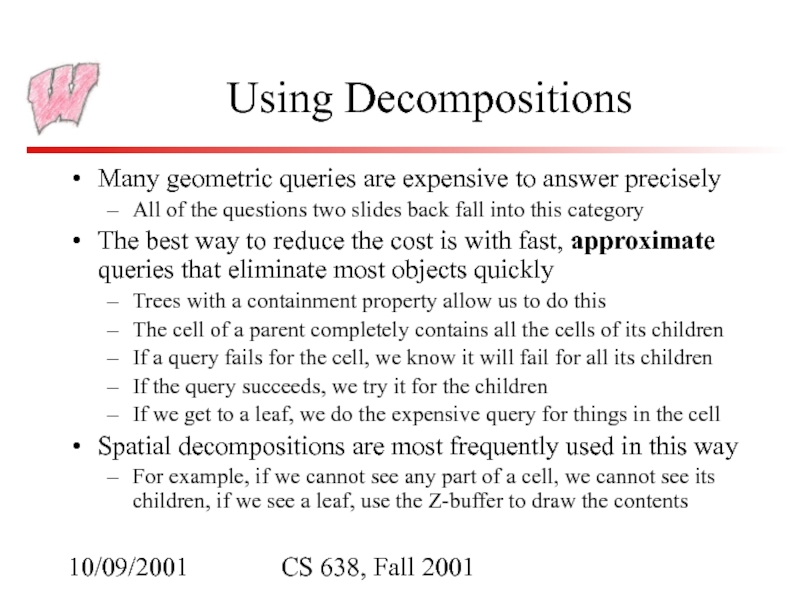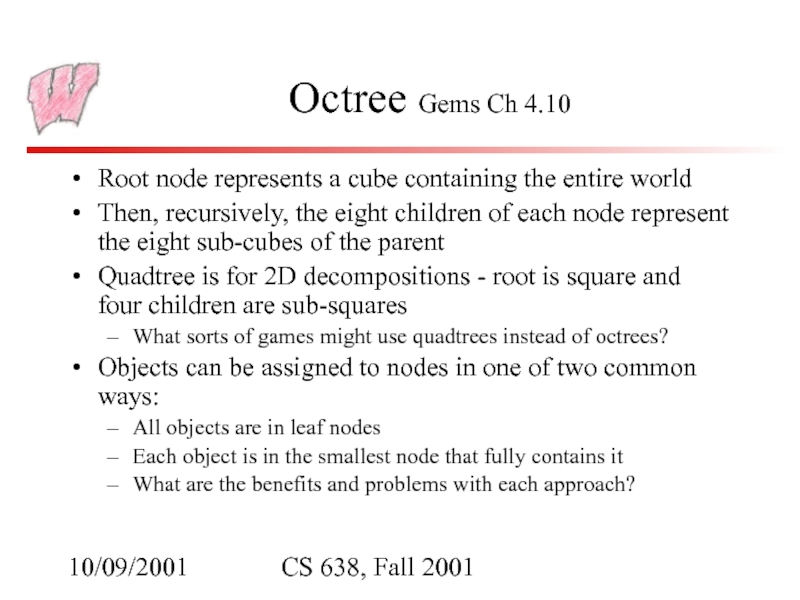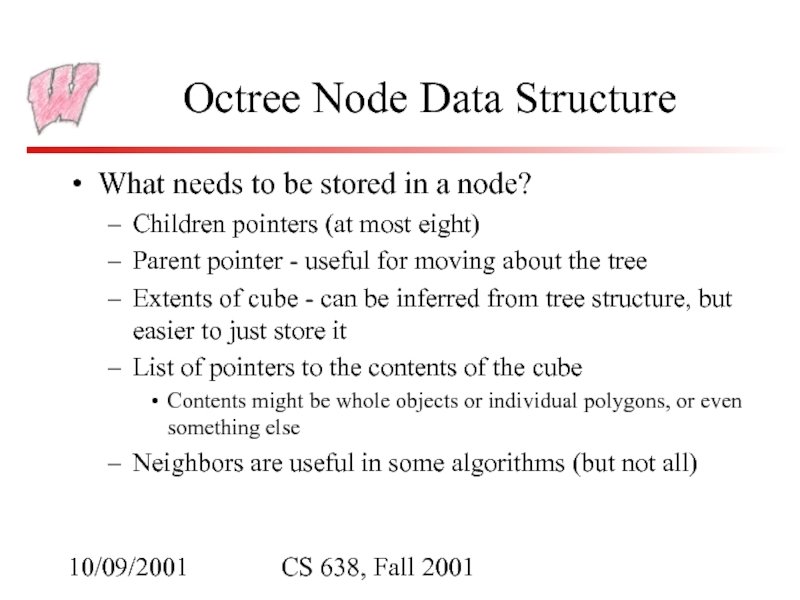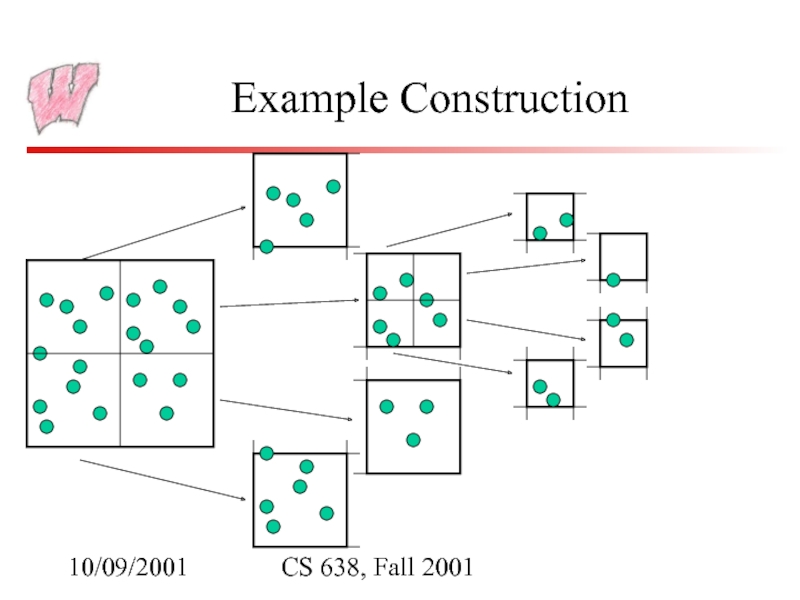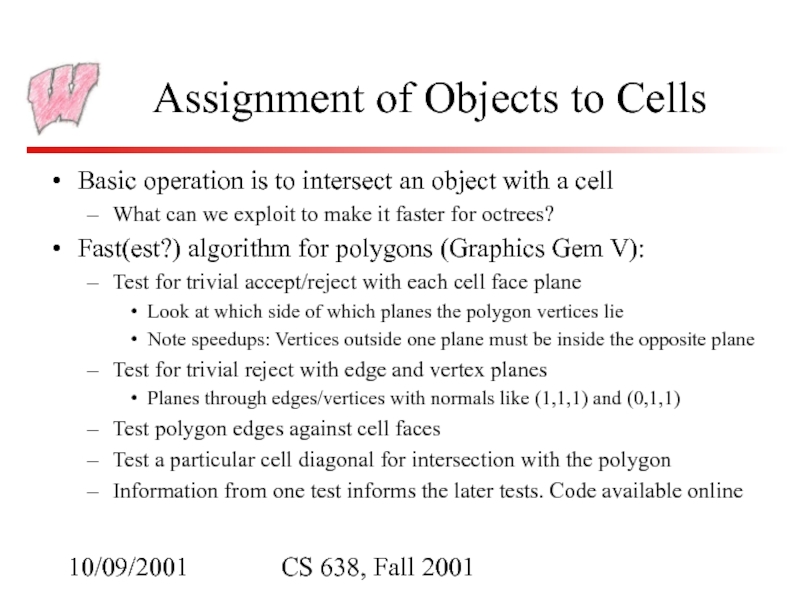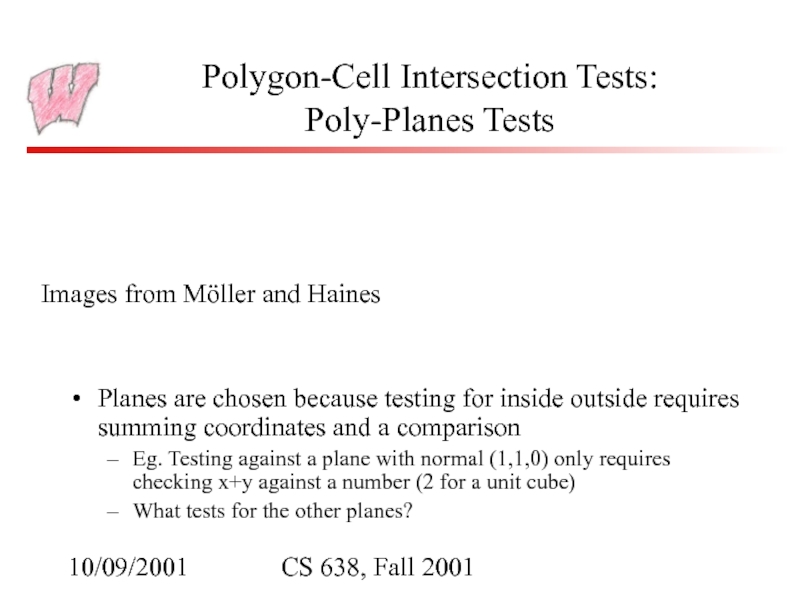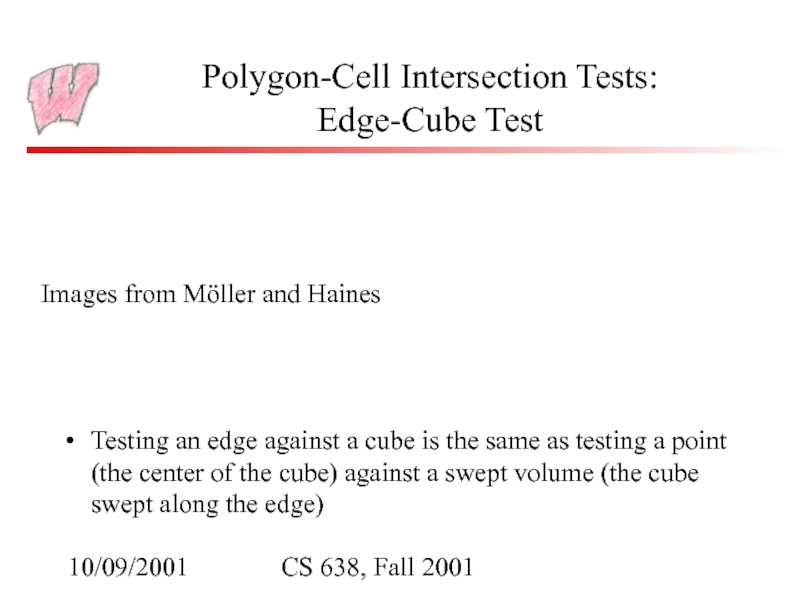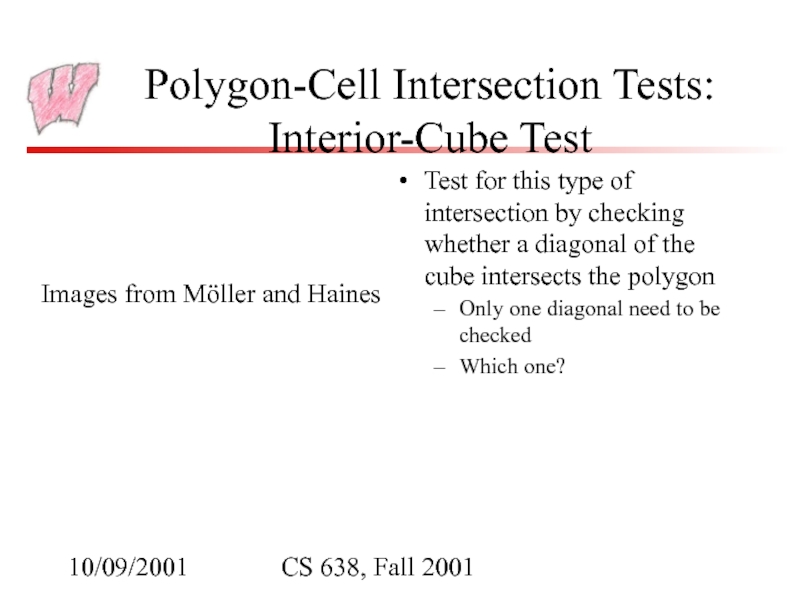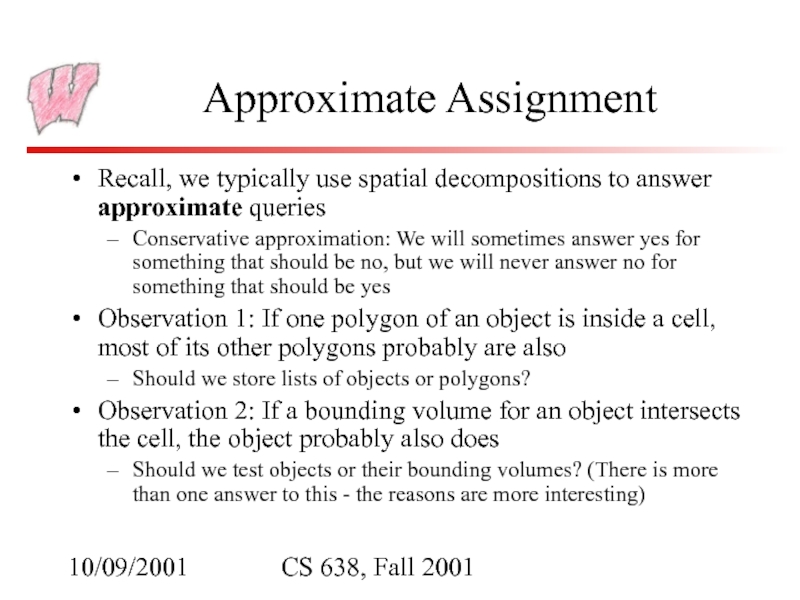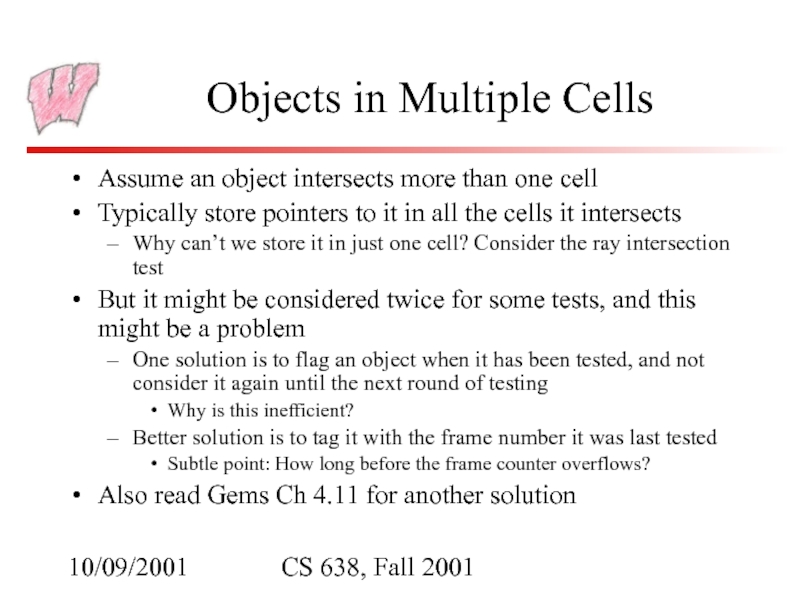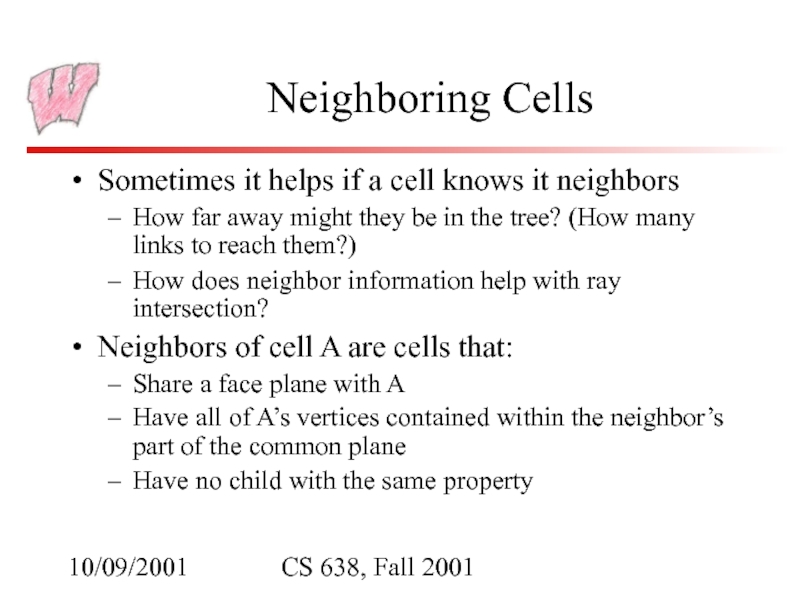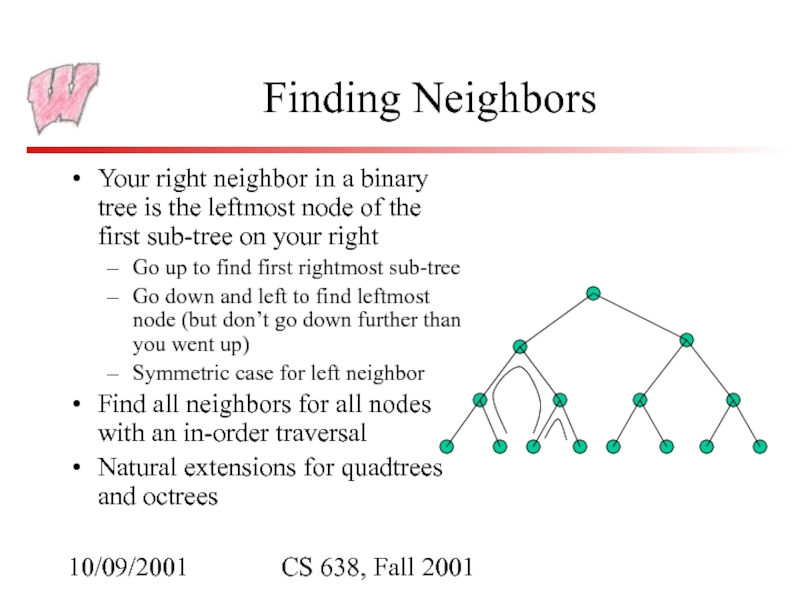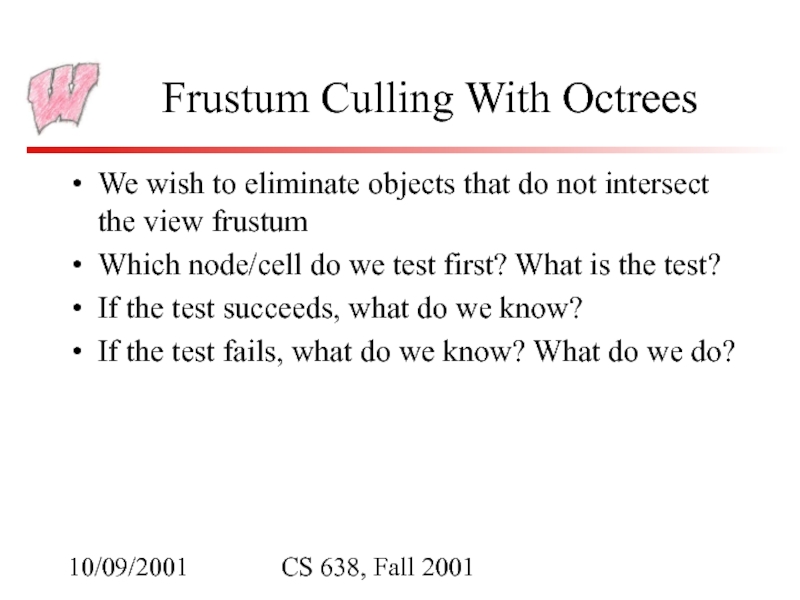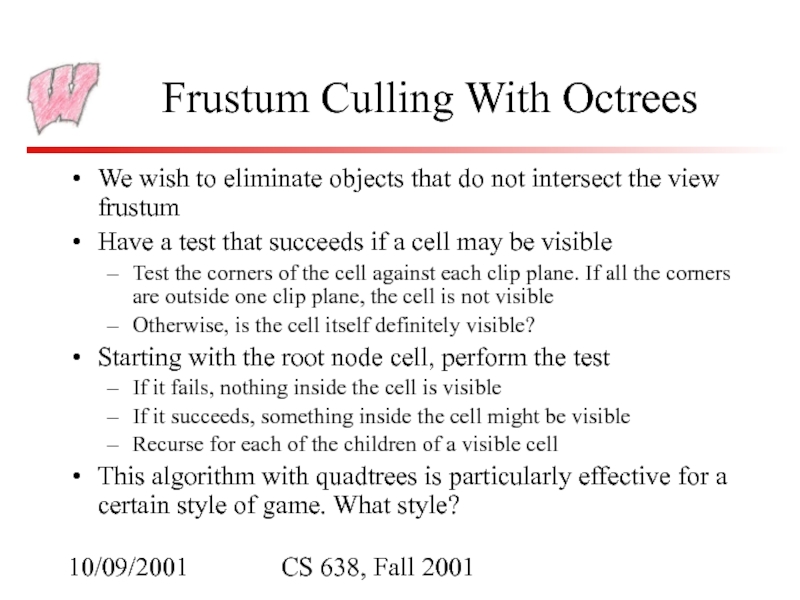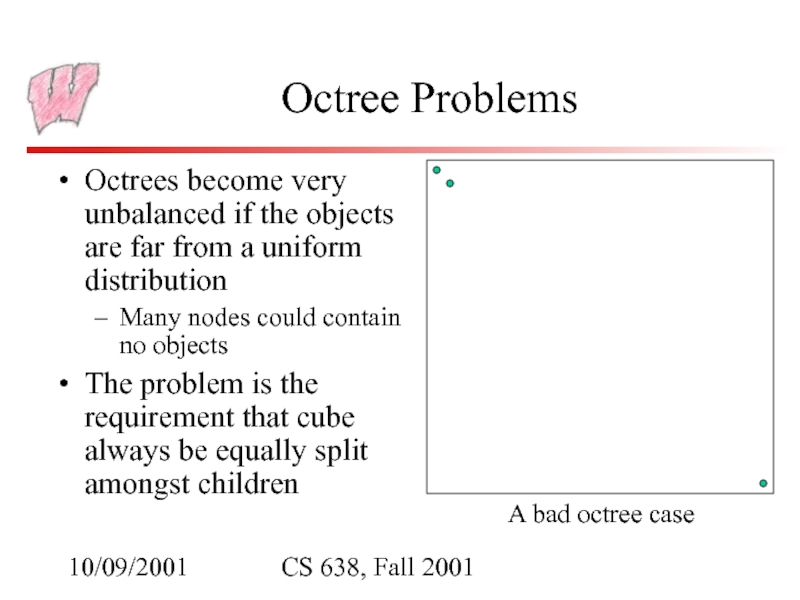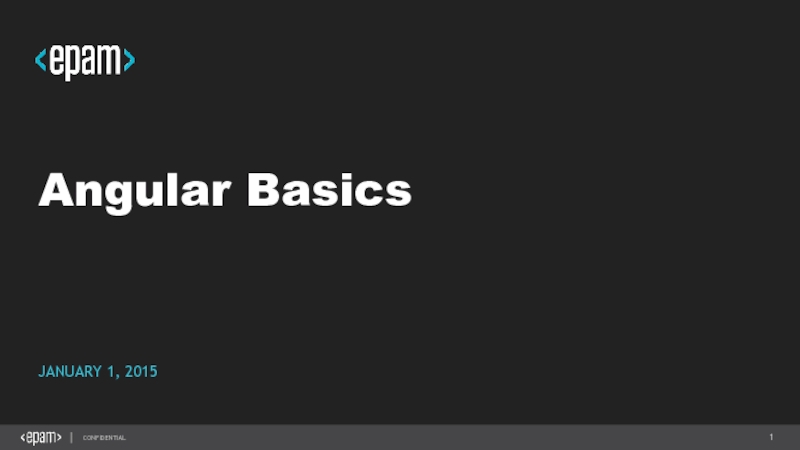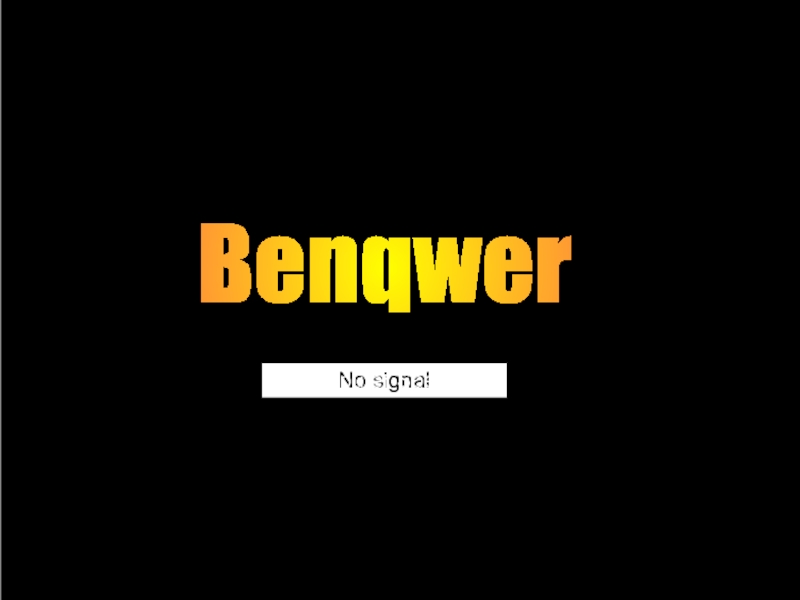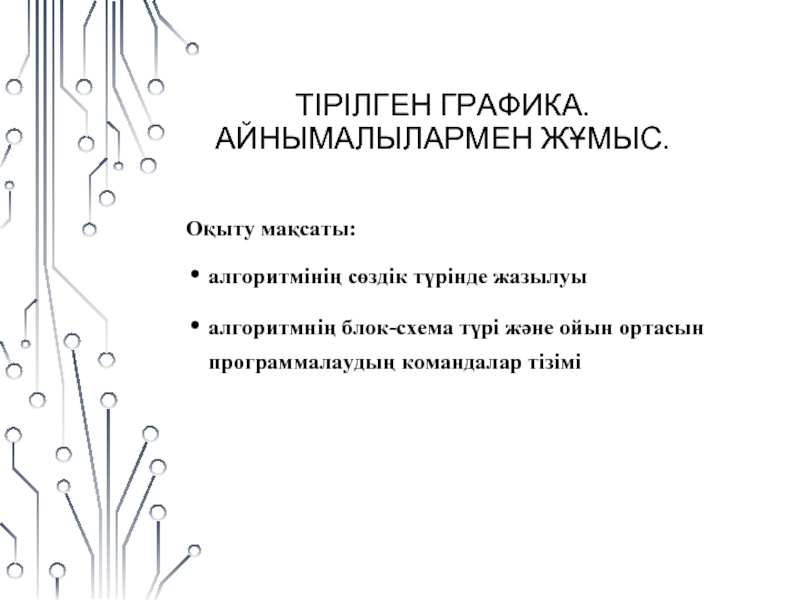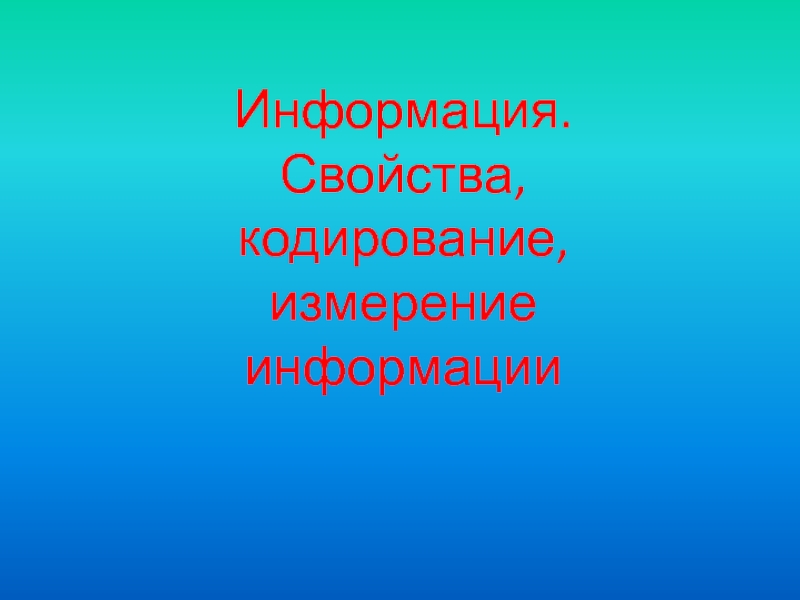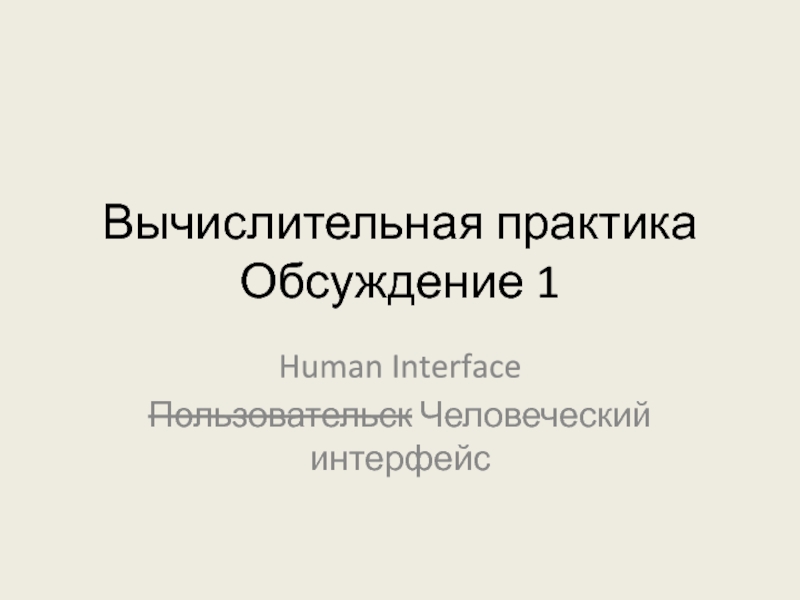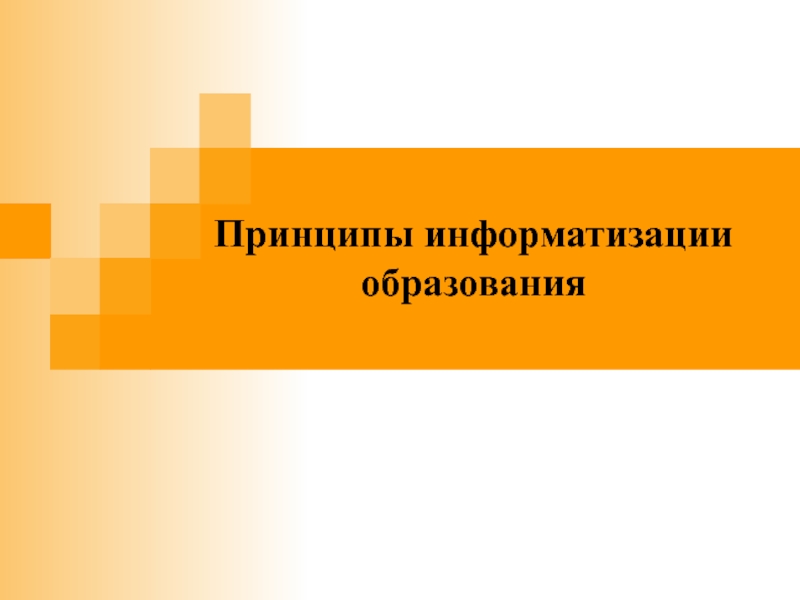- Главная
- Разное
- Дизайн
- Бизнес и предпринимательство
- Аналитика
- Образование
- Развлечения
- Красота и здоровье
- Финансы
- Государство
- Путешествия
- Спорт
- Недвижимость
- Армия
- Графика
- Культурология
- Еда и кулинария
- Лингвистика
- Английский язык
- Астрономия
- Алгебра
- Биология
- География
- Детские презентации
- Информатика
- История
- Литература
- Маркетинг
- Математика
- Медицина
- Менеджмент
- Музыка
- МХК
- Немецкий язык
- ОБЖ
- Обществознание
- Окружающий мир
- Педагогика
- Русский язык
- Технология
- Физика
- Философия
- Химия
- Шаблоны, картинки для презентаций
- Экология
- Экономика
- Юриспруденция
Spatial Data Structures презентация
Содержание
- 1. Spatial Data Structures
- 2. 10/09/2001 CS 638, Fall 2001 Spatial Data
- 3. 10/09/2001 CS 638, Fall 2001 Spatial Decompositions
- 4. 10/09/2001 CS 638, Fall 2001 Using Decompositions
- 5. 10/09/2001 CS 638, Fall 2001 Octree Gems
- 6. 10/09/2001 CS 638, Fall 2001 Octree Node
- 7. 10/09/2001 CS 638, Fall 2001 Building an
- 8. 10/09/2001 CS 638, Fall 2001 Example Construction
- 9. 10/09/2001 CS 638, Fall 2001 Assignment of
- 10. 10/09/2001 CS 638, Fall 2001 Polygon-Cell Intersection
- 11. 10/09/2001 CS 638, Fall 2001 Polygon-Cell Intersection
- 12. 10/09/2001 CS 638, Fall 2001 Polygon-Cell Intersection
- 13. 10/09/2001 CS 638, Fall 2001 Approximate Assignment
- 14. 10/09/2001 CS 638, Fall 2001 Objects in
- 15. 10/09/2001 CS 638, Fall 2001 Neighboring Cells
- 16. 10/09/2001 CS 638, Fall 2001 Finding Neighbors
- 17. 10/09/2001 CS 638, Fall 2001 Frustum Culling
- 18. 10/09/2001 CS 638, Fall 2001 Frustum Culling
- 19. 10/09/2001 CS 638, Fall 2001 Octree Problems
Слайд 210/09/2001
CS 638, Fall 2001
Spatial Data Structures
Spatial data structures store data indexed
For instance, store points according to their location, or polygons, …
Before graphics, used for queries like “Where is the nearest McDonalds?” or “Which stars are strong enough to influence the sun?”
Multitude of uses in computer games
Visibility - What can I see?
Ray intersections - What did the player just shoot?
Collision detection - Did the player just hit a wall?
Proximity queries - Where is the nearest power-up?
Слайд 310/09/2001
CS 638, Fall 2001
Spatial Decompositions
Focus on spatial data structures that partition
Generally, cut up space with planes that separate regions
Always based on tree structures (surprise, huh?)
Octrees (Quadtrees): Axis aligned, regularly spaced planes cut space into cubes (squares)
Kd-trees: Axis aligned planes, in alternating directions, cut space into rectilinear regions
BSP Trees: Arbitrarily aligned planes cut space into convex regions
Слайд 410/09/2001
CS 638, Fall 2001
Using Decompositions
Many geometric queries are expensive to answer
All of the questions two slides back fall into this category
The best way to reduce the cost is with fast, approximate queries that eliminate most objects quickly
Trees with a containment property allow us to do this
The cell of a parent completely contains all the cells of its children
If a query fails for the cell, we know it will fail for all its children
If the query succeeds, we try it for the children
If we get to a leaf, we do the expensive query for things in the cell
Spatial decompositions are most frequently used in this way
For example, if we cannot see any part of a cell, we cannot see its children, if we see a leaf, use the Z-buffer to draw the contents
Слайд 510/09/2001
CS 638, Fall 2001
Octree Gems Ch 4.10
Root node represents a cube
Then, recursively, the eight children of each node represent the eight sub-cubes of the parent
Quadtree is for 2D decompositions - root is square and four children are sub-squares
What sorts of games might use quadtrees instead of octrees?
Objects can be assigned to nodes in one of two common ways:
All objects are in leaf nodes
Each object is in the smallest node that fully contains it
What are the benefits and problems with each approach?
Слайд 610/09/2001
CS 638, Fall 2001
Octree Node Data Structure
What needs to be stored
Children pointers (at most eight)
Parent pointer - useful for moving about the tree
Extents of cube - can be inferred from tree structure, but easier to just store it
List of pointers to the contents of the cube
Contents might be whole objects or individual polygons, or even something else
Neighbors are useful in some algorithms (but not all)
Слайд 710/09/2001
CS 638, Fall 2001
Building an Octree
Define a function, buildNode, that:
Takes a
Creates the children nodes, divides the objects among the children, and recurses on the children, or
Sets the node to be a leaf node
Find the root cube (how?), create the root node and call buildNode with all the objects
When do we choose to stop creating children?
Is the tree necessarily balanced?
What is the hard part in all this? Hint: It depends on how we store objects in the tree
Слайд 910/09/2001
CS 638, Fall 2001
Assignment of Objects to Cells
Basic operation is to
What can we exploit to make it faster for octrees?
Fast(est?) algorithm for polygons (Graphics Gem V):
Test for trivial accept/reject with each cell face plane
Look at which side of which planes the polygon vertices lie
Note speedups: Vertices outside one plane must be inside the opposite plane
Test for trivial reject with edge and vertex planes
Planes through edges/vertices with normals like (1,1,1) and (0,1,1)
Test polygon edges against cell faces
Test a particular cell diagonal for intersection with the polygon
Information from one test informs the later tests. Code available online
Слайд 1010/09/2001
CS 638, Fall 2001
Polygon-Cell Intersection Tests:
Poly-Planes Tests
Planes are chosen because testing
Eg. Testing against a plane with normal (1,1,0) only requires checking x+y against a number (2 for a unit cube)
What tests for the other planes?
Images from Möller and Haines
Слайд 1110/09/2001
CS 638, Fall 2001
Polygon-Cell Intersection Tests:
Edge-Cube Test
Testing an edge against a
Images from Möller and Haines
Слайд 1210/09/2001
CS 638, Fall 2001
Polygon-Cell Intersection Tests:
Interior-Cube Test
Test for this type of
Only one diagonal need to be checked
Which one?
Images from Möller and Haines
Слайд 1310/09/2001
CS 638, Fall 2001
Approximate Assignment
Recall, we typically use spatial decompositions to
Conservative approximation: We will sometimes answer yes for something that should be no, but we will never answer no for something that should be yes
Observation 1: If one polygon of an object is inside a cell, most of its other polygons probably are also
Should we store lists of objects or polygons?
Observation 2: If a bounding volume for an object intersects the cell, the object probably also does
Should we test objects or their bounding volumes? (There is more than one answer to this - the reasons are more interesting)
Слайд 1410/09/2001
CS 638, Fall 2001
Objects in Multiple Cells
Assume an object intersects more
Typically store pointers to it in all the cells it intersects
Why can’t we store it in just one cell? Consider the ray intersection test
But it might be considered twice for some tests, and this might be a problem
One solution is to flag an object when it has been tested, and not consider it again until the next round of testing
Why is this inefficient?
Better solution is to tag it with the frame number it was last tested
Subtle point: How long before the frame counter overflows?
Also read Gems Ch 4.11 for another solution
Слайд 1510/09/2001
CS 638, Fall 2001
Neighboring Cells
Sometimes it helps if a cell knows
How far away might they be in the tree? (How many links to reach them?)
How does neighbor information help with ray intersection?
Neighbors of cell A are cells that:
Share a face plane with A
Have all of A’s vertices contained within the neighbor’s part of the common plane
Have no child with the same property
Слайд 1610/09/2001
CS 638, Fall 2001
Finding Neighbors
Your right neighbor in a binary tree
Go up to find first rightmost sub-tree
Go down and left to find leftmost node (but don’t go down further than you went up)
Symmetric case for left neighbor
Find all neighbors for all nodes with an in-order traversal
Natural extensions for quadtrees and octrees
Слайд 1710/09/2001
CS 638, Fall 2001
Frustum Culling With Octrees
We wish to eliminate objects
Which node/cell do we test first? What is the test?
If the test succeeds, what do we know?
If the test fails, what do we know? What do we do?
Слайд 1810/09/2001
CS 638, Fall 2001
Frustum Culling With Octrees
We wish to eliminate objects
Have a test that succeeds if a cell may be visible
Test the corners of the cell against each clip plane. If all the corners are outside one clip plane, the cell is not visible
Otherwise, is the cell itself definitely visible?
Starting with the root node cell, perform the test
If it fails, nothing inside the cell is visible
If it succeeds, something inside the cell might be visible
Recurse for each of the children of a visible cell
This algorithm with quadtrees is particularly effective for a certain style of game. What style?
Слайд 1910/09/2001
CS 638, Fall 2001
Octree Problems
Octrees become very unbalanced if the objects
Many nodes could contain no objects
The problem is the requirement that cube always be equally split amongst children
A bad octree case
